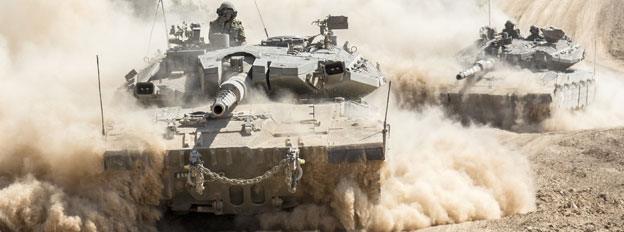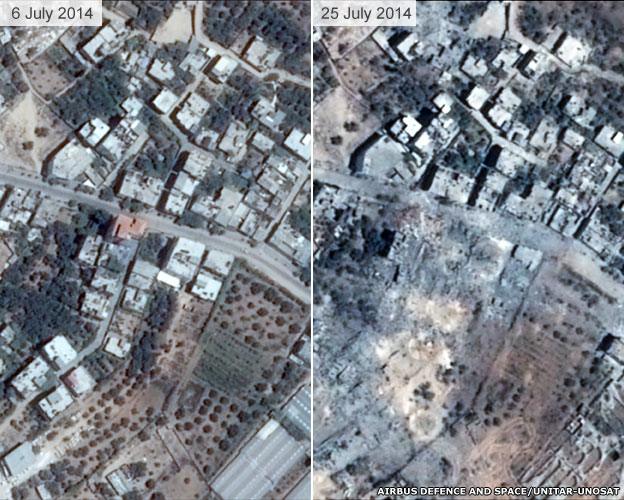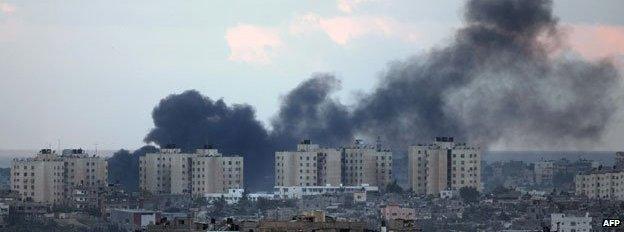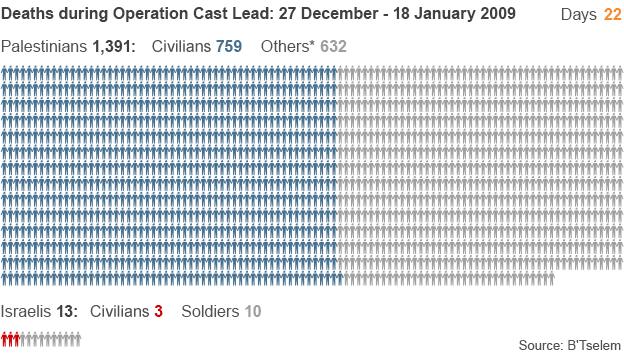Gaza crisis: Toll of operations in Gaza
- Published
The number of civilians killed during Israel's Operation Protective Edge offensive has raised international concern and condemnation.
Between 8 July and 27 August, more than 2,100 Palestinians were killed in the Gaza Strip, along with 66 Israeli soldiers and seven civilians in Israel.
The UN says the vast majority of Palestinian deaths are civilian. But figures from previous operations over the past six years in the densely populated Gaza Strip show it is not the first time civilians have paid a heavy price.
2014: Operation Protective Edge

The overwhelming majority of those killed were Palestinians.
The UN says at least 2,104 Palestinian died, including 1,462 civilians, of whom 495 were children and 253 women.
An Israeli government official told the BBC that the Israel Defense Forces (IDF) had killed 1,000 "terrorists" during the assault on Gaza.

Figures for Palestinian deaths are to 27 August

Israel also suffered casualties in the operation - 66 Israeli military personnel died, while six Israeli civilians and a Thai national were killed by rockets and mortars fired from Gaza.

On 26 August, 50 days after the operation was launched, Israel and Palestinian factions in Gaza agreed an open-ended ceasefire brokered by Egypt.
The IDF says Hamas fired at least 4,591 rockets towards Israel between 8 July and 31 August - with more than 735 intercepted by its Iron Dome anti-missile systems. It says its own forces have hit at least 5,226 targets in Gaza. A number of UN buildings have also been hit, while people were sheltering inside.

Analysis: Anthony Reuben, Head of statistics, BBC News
It should be said that while Hamas said only 50 fighters had been killed in 2008-09, some human rights groups operating in Gaza were reporting considerably higher figures.
The point is that it is hard to say with certainty at this stage how many of the dead in Gaza are civilians and how many were fighters. This is in no sense the fault of the UN employees collecting the figures - their statistics are accompanied by caveats and described as preliminary and subject to revision.
But it does mean that some of the conclusions being drawn from them may be premature.

Israel accuses Hamas of firing rockets at Israeli civilians while hiding behind Palestinian civilians. It said its forces had "gone to unprecedented lengths to keep Palestinian civilians out of harm's way, including by dropping leaflets, making phone calls and sending text messages", as well as aborting strikes.
Life in Gaza
1.8m
people living in Gaza
4,505
per square kilometre
-
475,000 living in emergency shelters or with other families
-
17,200 homes destroyed or severely damaged by Israeli attacks
-
244 schools damaged
Israel has been criticised for using the so-called "knock on the roof" method - warning people of impending airstrikes by launching a non-explosive missile before the main strike. Some airstrikes have occurred less than a minute later.
Satellite images released by the United Nations show how a section of Shijaia neighbourhood in Gaza City has been razed by attacks since 8 July.

2012: Operation Pillar of Defense

Israel's previous major air strike offensive on Gaza was Operation Pillar of Defense in November 2012.
It began with an air strike that killed the commander of Hamas's military wing, Ahmed Jabari, whom it accused of responsibility for "all terrorist activities against Israel from Gaza" over the past decade.
Prior to the operation, there had been spates of Palestinian militant groups, including Hamas's Qassam Brigades, firing hundreds of rockets into southern Israel and the Israeli military shelling Gaza and carrying out air strikes.
An Israeli human rights group, B'Tselem, external, said 167 Palestinians were killed, including 87 civilians. Six Israelis - two soldiers and four civilians - were also killed.

*B'Tselem defines OTHERS as Palestinians killed taking part in hostilities, those killed in targeted killings, police officers and others where it was unclear whether they were involved in the fighting.
Key parts of Gaza's infrastructure were damaged or destroyed by Israeli airstrikes, including the Hamas prime minister's office, a government compound which housed the interior ministry and the tunnels used for smuggling everything from food to weapons in the south. Apartment buildings, sports fields, kindergartens and electricity substations were also hit.
2008-2009: Operation Cast Lead

Israeli air strike on the Jabalia refugee camp in the southern Gaza Strip
The last time Israeli ground troops went into Gaza was in December 2008, as part of Operation Cast Lead. Around 1,391 Palestinians were killed, including an estimated 759 civilians, according to B'Tselem, external. Reports say this included 344 children and 110 women.

*B'Tselem defines OTHERS as Palestinians killed taking part in hostilities, those killed in targeted killings, police officers and others where it was unclear whether they were involved in the fighting.
Israel's military had put the overall Palestinian death toll at 1,166, of whom it said 295 were "uninvolved" civilians. The Palestinian Centre for Human Rights, external estimates that 1,417 Palestinians died, 926 of whom were civilians.
An Amnesty International report, external into the operation said lives were lost because Israeli forces "frequently obstructed access to medical care." It also condemned the use of "imprecise" weapons such as white phosphorous and artillery shells.
Amnesty also said Hamas and other Palestinian militant groups had endangered Palestinian civilians by firing rockets from residential neighbourhoods and storing weapons in them.
Israel lost 10 members of the security forces in the three-week offensive, including four by so-called "friendly fire". Three Israeli civilians were also killed.